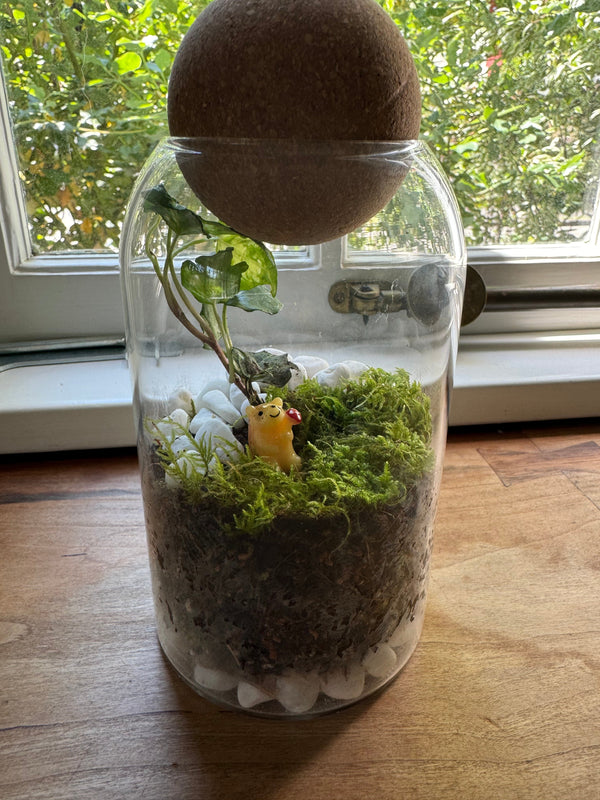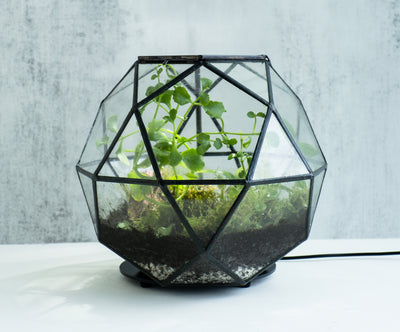Making a closed terrarium is essentially creating a miniature Earth in a jar. It comes with many complications and challenges, and we need to take care of various failure points to establish a long-lasting, self-sustaining ecosystem.
Content Summary
- Understanding Self-Sustaining Terrariums
- Necessary Materials
- Selecting the Perfect Terrarium Container
- Creating the Drainage Layer
- Preparing the Soil Mixture
- Adding the Soil Mix
- Cleaning the Terrarium Jar Walls
- Adding the Plants
- Adding Decorations
- Sealing and Maintaining Your Closed Terrarium
- Expected Longevity
- Light Requirements
As a long-time terrarium maker, I have faced many failures. Many of my terrariums died for various reasons. In this blog post, I will share how to make a perfect closed ecosystem using healthy plants. By following my process, you will have a foolproof terrarium.
I will also cover beginner mistakes. I’ve seen many as I have been teaching terrarium classes for years.
Let’s start with the basics:
What Does "Self-Sustaining Terrarium" Mean?
A self-sustaining terrarium means everything in this small jar needs to be reused within itself to sustain its ecosystem. This concept is often referred to as a terrarium ecosystem, where natural cycles like the rain cycle and nutrient cycle maintain equilibrium.
I start my classes with the etymology of “terrarium.” “Terra” means Earth, and “terrarium” means Earth in a container. You can compare it to “aquarium,” which means water in a container, or “solarium,” which means sun in a container.
We will mimic Earth, as it is the only example we have of a sustainable ecosystem. We will create a tropical terrarium, which is the easiest to build.
Necessary Materials
-
Glass terrarium jar with a lid (alternatively a glass jar)
-
Tropical plant check out best plants
-
Fresh moss
-
Moisture control soil
-
Peat moss
-
Sphagnum moss
-
Activated carbon
-
Pebbles (alternatively marble chips or lava rocks)
-
Terrarium landscaping tools
-
Burlap (alternatively metal mesh)
-
Scissors
-
Wooden stick
-
Paper towel
-
Water
-
Marker
-
Decorations
Check where to buy all the materials here
Selecting the Perfect Terrarium Container
This step is one of the most important. Many terrarium containers are available in the market, including clear glass or plastic containers like repurposed glass cookie or candy jars, fish bowls, fish tanks, and clear half-gallon canning jars. I won’t go into detail as I have a separate post for this. We will use a medium-sized glass container with a lid, making it airtight and watertight. You can start with a mason jar if you are looking for an easy-to-get option.
Creating the Drainage Layer
As we mimic Earth, we need to set the water cycle. On Earth, we have evaporation and condensation, allowing water to recycle. The first layer will be our drainage layer. We will use pebbles or marble chips, glass balls, or lava rocks—anything that won’t dissolve in water. Excess water will collect in this layer. Add a one-finger-high layer of pebbles to your jar. This should be enough, but you can add more for aesthetic reasons.
Preparing the Soil Mixture
The soil mix is crucial for a closed ecosystem. Prepare a soilless potting mix before adding it to the jar. Use a mixing cup or any tray you have at home.
-
Moisture Control Soil: This can be sourced from a home improvement store.
-
Peat Moss: Holds 20 times its dry weight in water, helping regulate moisture.
-
Sphagnum Moss: Fluffier than peat moss, creating gaps for water and air movement.
-
Activated Carbon: Essential for the gas cycle. Activated carbon generates CO2 and filters water, keeping it clear.
Mix these components until you reach a brownie mix consistency—not muddy, but not dry. Add water slowly and mix. For best results, avoid using standard potting soil and opt for a high-quality tropical substrate mix.
Adding the Soil Mix
Fill your jar up to one-third with the soil mix, leaving space for the gas cycle. Any extra mix can be used for another terrarium or saved for later.
Cleaning the Terrarium Jar Walls
After adding the soil mix, clean the jar walls with a paper towel and tweezers. This ensures your terrarium looks clean.
Adding the Plants
Selecting the right closed terrarium plants is crucial. It is important to choose small, slow-growing, or dwarf plants that fit into the container with room to spare. Most ferns and tropical plants thrive in a closed terrarium, but avoid succulents—they don’t tolerate constant moisture. Here are some tropical plants that work well in a closed terrarium:
-
Fittonia (Nerve Plant)
-
Pilea
-
Peperomia
-
Ferns
-
Mosses
Remove existing soil from the multiple plants, keeping only the roots and a small amount of soil. Plant them in the jar. You can also add live moss as a secondary plant; it absorbs moisture from the air. Position the tallest plant to dictate the layout of the land and create an aesthetically pleasing design.
Adding Decorations
Avoid adding wood, as it can mold. Use materials like seashells, rocks, glass, resin, or plastic for decoration.
Sealing and Maintaining Your Closed Terrarium
Seal your terrarium and monitor it for two weeks. If it appears over-watered, open the seal for a few hours to let excess moisture evaporate. If it seems under-watered, add a small amount of water and reseal. Adjust as necessary until you find the perfect balance. Additionally, remember to prune plants when they are yellowing, touching the glass, or getting too large to maintain the terrarium.
Expected Longevity
With proper care, a closed terrarium can last indefinitely. The oldest known closed terrarium has been sealed for over 50 years. As long as the balance of water, light, and air is maintained, your terrarium can thrive for many years.
Light Requirements
A closed terrarium needs indirect sunlight. Too much direct sunlight can cause overheating and too little can stunt plant growth. Place your terrarium in a spot where it receives bright, indirect light, such as near a north-facing window. Low-light conditions can also work if you use plants suited for low light, but bright, indirect light is ideal for a thriving terrarium.
Final Thoughts
Creating a closed terrarium is a rewarding experience that mirrors Earth's intricate balance. For a visual guide, you can watch our step-by-step video on making a closed terrarium. Additionally, we offer a variety of terrarium kits to help you get started.
Happy terrarium building!

